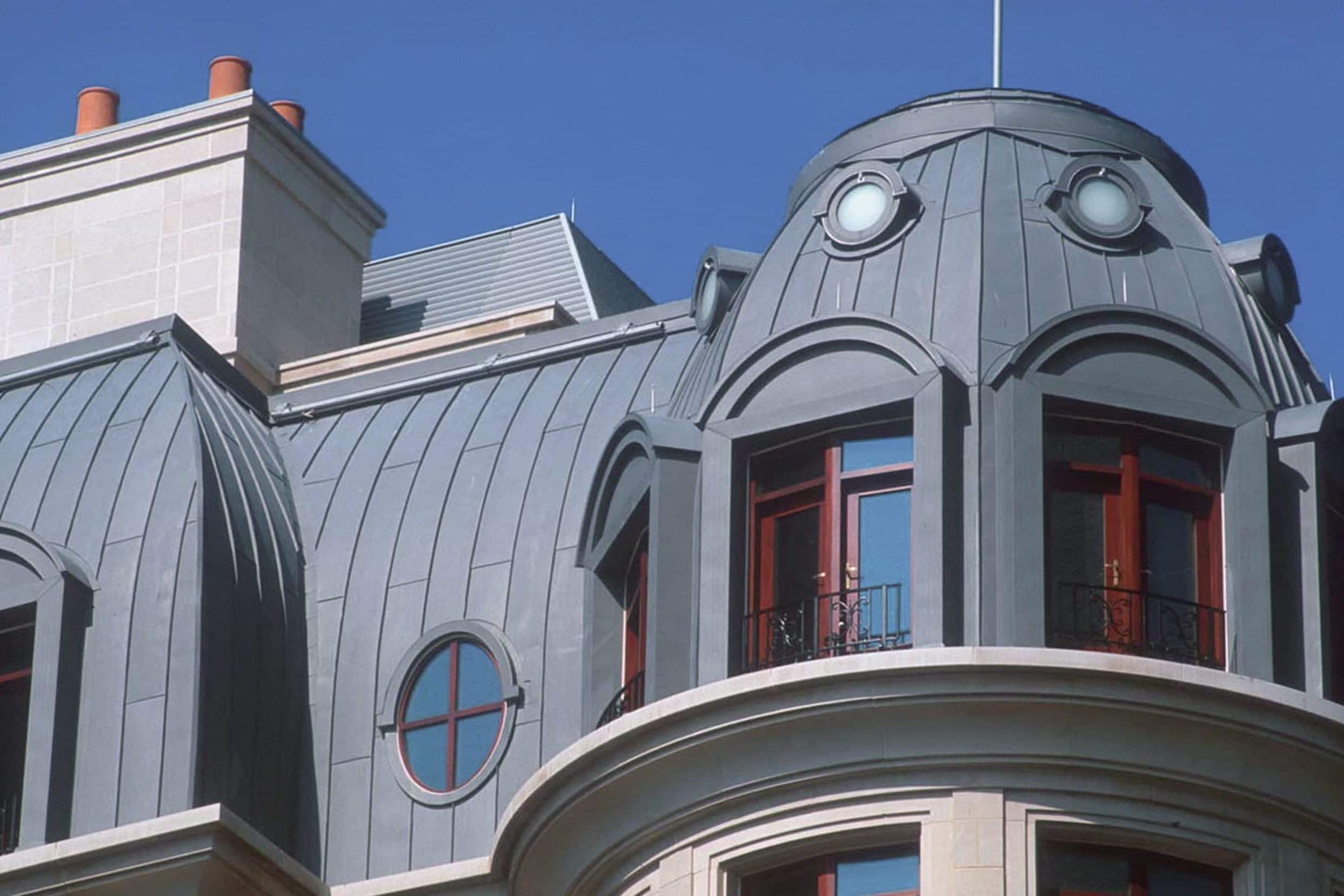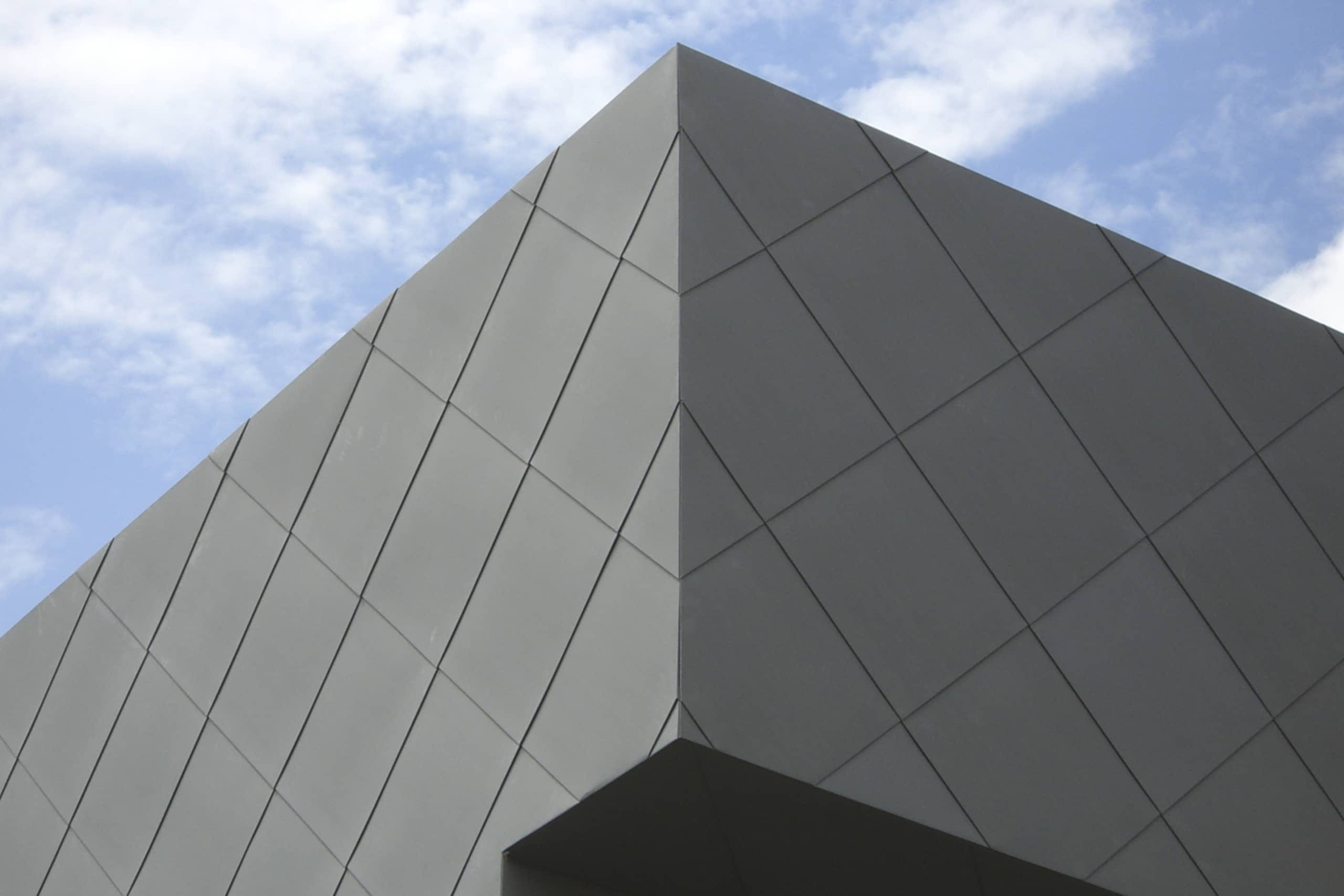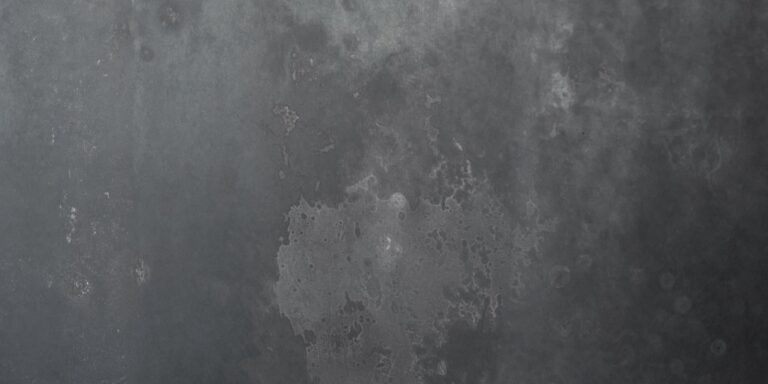Get Inspiration, Delivered.
Join our newsletter and get inspiring projects, educational resources, and other cool metal stuff, straight to your inbox.
Early uses of zinc as cladding for roofs or castings were relatively pure, which represented great beauty, however, those purest forms are not what’s used today. And for good reason: alloys or combinations of metals are typically the strongest, most durable, and most attractive forms of this remarkable metal.
As with other advancements in metallurgy and engineering, various industries that use zinc have developed alloys that capitalize on the metal’s specific characteristics. With zinc, however, the differences and advancements have been quite subtle yet important.
As an example, the architectural use of zinc today would be limited if not for the alloying elements of copper and titanium. This has enabled zinc to perform in a similar fashion to other thin sheet metals used as surface cladding.

Macro image of native copper, about 1 ½ inches (4 cm) in size.
Jonathan Zander (Digon3), Creative Commons Attribution-Share Alike 3.0 Unported license, unedited.

A ~5.5″ long, 99.995% pure titanium crystal bar made via the iodide process.
Alchemist-hp, Creative Commons Attribution-Share Alike 3.0 Unported license, unedited.
Another alloying element added to zinc is aluminum. Die cast zinc is most always an alloy of zinc and aluminum. Aluminum is added to benefit strength while still enabling the metal to be cast. The alloys of zinc are designed specifically for an industry. The copper-titanium alloys are not used in casting, nor are the aluminum-zinc alloys used in roof cladding.
The marketplace for zinc is tighter than for other metals. The diversification of zinc into other areas is limited by the mechanical behavior of the metal. Zinc is weaker than other metals and this limits the metal to industries and systems not subject to high stress conditions. You would never think of using beams and columns made out of zinc, nor would an airplane manufactured from zinc be very safe.
Zinc does not have many metals that can go into solid solution with it. Zinc can only accept small amounts of other metals into its compact hexagonal structure. Gold and silver can form solid solutions with zinc up to around 10%, whereas copper, which accepts as much as 39% zinc to form brass alloys, can only be absorbed into the zinc matrix to around 3%.

Micrograph of a dendrite in a shrinkage cavity in zinc – 15% aluminum alloy sample.
Bazhenov Vyacheslav, Creative Commons Attribution-Share Alike 4.0 International license, cropped.
Zinc does form several important binary alloys. The combination of zinc and aluminum is an important die cast alloy. The alloy of zinc and iron are critical for the interface of zinc to steel in the galvanizing process. Zinc and copper are binary alloys used to make the metal harder and provide the base alloy that is plated with copper to make the copper penny.
The major ternary zinc alloy is composed of zinc, copper, and titanium. The development of this alloy has greatly improved the thin rolled-zinc product for architectural cladding.
Alloying elements are important but have a limited effect on the mechanical performance of zinc. Improvement in hardness and creep resistance are the most important aspects. Cold working and heat strengthening have little effect on zinc due to the way the atoms fall back in alignment after deformation. It essentially recrystallizes at room temperature once the deformation occurs.

A die cast engine block.
160SX, Creative Commons Attribution-Share Alike 3.0 Unported, unedited.
The zinc alloys over the past century have undergone development and specialization much the same as other metals. Conventional foundries in the United States were slow to use zinc as a casting metal. The metal was not well understood, and cast alloys were considered more for the die casting of smaller custom parts. Slush casting was used by several specialized foundries in the late 1800s and early 1900s, but this fell away from interest after World War I with respect to art and architecture.
The low melting temperature and fluidity, however, make zinc an exceptional material for high-detail casting. The art world in Europe recognized this, and in the late 1800s to early 1900s used zinc to create some magnificently detailed work.
Over the years, the various zinc manufacturers sought to brand their specific alloys with names or numbers that distinguished their product from that of a competitor – Titanaloy, Microzine 80, Alloy 190, and so on.
Today, the distinction of zinc products is mostly made by the color tone offered by various manufacturers and their branded surface finish names. We’ll address those later in this blog, and in the next post of this series featuring zinc brand name finishes.

Steel surface galvanized with zinc.

Die cast zinc toy car circa 1966-1972.
Auckland Museum CC BY

Zinc oxide.
Adam Rędzikowski, Creative Commons Attribution-Share Alike 4.0 International license, unedited.
The Various Uses of Zinc
Protecting steel and iron parts by the sacrificial character created by the hot-dipped galvanized process occupies close to 50% of the zinc used worldwide. Second to galvanized steel, zinc is used to make brass and other copper alloys. Using zinc to make copper harder and stronger has been underway for centuries, even before the metal was known to exist. As zinc is added, up to approximately 40%, copper alloys turn more yellow or golden and increase in strength and hardness.
Die-cast forms and shapes from zinc alloys are innumerable. They are used in the automotive, toy, computer, electrical, and any number of industries that utilize production casting with high accuracy. Zinc can be quickly cast into inexpensive parts. Zinc is easy to machine, and cleanup is minimal as well.
The non sparking aspect of zinc makes it ideal for small gasoline engine parts and sensitive appliance parts. Zinc is corrosion resistant to most fluids and in most atmospheres. Acidic substances and strong bases should be avoided, but most other near pH neutral fluids and solvents will not harm it unless they remain on the zinc surface in a confined space.
Chemicals and ointments use zinc in powder form or combined with other substances. Zinc-rich paint, another method used to provide a protective coating for steels, uses zinc powders dispersed throughout a resin. Zinc white paint is created from zinc oxide.

65 E. Goethe Street, designed by Lucien Lagrange, features preweathered zinc cladding.
Rolled-Zinc Innovations and Alloys Used for Architecture
Rolled products include plate, sheet, strip, and foil. These are the alloys where the primary architectural alloys reside. Rolled-zinc alloys are also the initial form used to make coinage and the common household battery.
Zinc roofing, flashing, gutters, and zinc wall panels are made from rolled-zinc sheets. These are composed of the alloys specially designed for the rigors of environmental exposures. Prior to the 1960s, zinc roofing was made from unalloyed sheets.
Early zinc sheets were subject to creep, a condition where the metal had a tendency to elongate under load. Unalloyed zinc is weak. No amount of cold working would improve the strength or hardness. Unalloyed zinc is brittle and will crack if worked in temperatures below room temperatures. Early zinc was produced in thicker sheets to accommodate the weakness and creep tendency.
In 1944, the New Jersey Zinc Company patented an alloy of zinc with titanium and manganese and this was a big improvement. However, it was the work of Dr. Erich Pelzel of Stolberge Zinc AG in Germany in 1949 that changed everything for the advancement of zinc in architecture.
Dr. Pelzel is credited with alloying zinc with miniscule amounts of copper and titanium to develop optimal creep resistance, ductility, and tensile strength.
Today, these copper-titanium-zinc rolled sheets are in use around the world. Major manufacturers are creating sheets in continuous casting machines where the zinc is melted, copper and titanium are added, and the alloy is passed through a set of moving ceramic coated belts that are cooled by water. The zinc solidifies into a thick plate that continues on to be reduced in a series of rolls.
Unlike stainless steel, copper, and aluminum, sheet forms of zinc are sold as a branded products rather than a commodity. Notably, most sheet zinc is supplied to the architectural world as preweathered — a treatment to form a matte, low-reflective oxide on the surface.
Common Alloying Elements in Zinc
- Aluminum is added to zinc die cast alloys to increase strength and to reduce grain size. Aluminum improves cast ability and fluidity of the casting.
- Copper increases hardness and strength. Small additions of copper will greatly improve tensile strength. Copper also helps combat inter crystalline corrosion in castings.
- Titanium induces fine grain development. This aids in creep resistance particularly when coupled with small amounts of copper.
- Iron is often a trace element picked up during the process of casting.
- Lead is a trace contaminant commonly present during the mining of zinc.
- Cadmium also often accompanies zinc ore. Cadmium increases stiffness and improves etching and engraving quality.
- Tin is a trace element that can cause subsurface corrosion in die casting, and embrittlement in rolled alloys.
- Magnesium in small amounts improves hardness.

The Zahner headquarters expansion designed by Crawford Architects features approx. 2,500 amorphous zinc cladding panels.
PHOTO © A. ZAHNER COMPANY.

NINE UNIQUE SHAPES COMPRISE THE ZINC SKIN.
PHOTO © A. ZAHNER COMPANY.

The color of the zinc cladding on the Zahner headquarters expansion ranges from deep gray to reflective silver depending on the light.
PHOTO © A. ZAHNER COMPANY.
An Introduction to Zinc Finishes
When we think of zinc, the dark gray roofs of the Paris skyline come to mind, as does the spangled, white gray of galvanization. Today it is used more frequently as an architectural cladding material comparable to copper and painted aluminum.
The beauty and behavior of the zinc surface is unlike any of the other metals used in art and architecture. It is a natural material, an element, not unlike aluminum and copper in the sense that it changes in appearance as it interacts with the light of the day and the conditions of the environment.
New patination techniques and enhancements to the surface of zinc are only recently being explored and introduced to the art and architectural marketplace. Designers are just now beginning to embrace the beauty and nature of zinc.
The working knowledge needed to build with the various forms of the metal are advancing as well. Casting and texturing of the zinc surface are finding new interest. The future of the metal as an architectural and artistic surfacing material beyond roofing and guttering has great potential.

Close-up of zinc surface.

Detail view of Zahner’s preweathered Hunter Zinc surface.
PHOTO © A. ZAHNER COMPANY.

Zinc B001, a concept surface from Zahner, is a preweathered zinc patina that rivals the appearance of blackened steel.
PHOTO © A. ZAHNER COMPANY.
The Colors, Finishes and Patinas of Zinc
Zinc is expected to weather, but it is very slow and predictable. Like the roofs in Paris, ranging from 300-year-old surfaces to those newly installed, it all blends together quite well. The oxide that forms over time is not thick and the preweathered new zinc surface is similar in appearance.
The oxide that forms over years of exposure is zinc carbonate. Zinc pulls carbon dioxide out of the surrounding air and captures it as an inert, stable layer on the surface.
For use in art and architecture applications, zinc is available from the mill source in sheet, plate, and ingot form. Zinc is available from secondary fabricators and manufacturers like Zahner in other forms.
Galvanizing of steel, for example, is performed by a secondary facility that acquires the zinc ingots and melts them to create a molten bath of metal for steel. Patinated, textured, and expanded zinc are available from firms that take the rolled zinc mill forms and convert the surface further to enhance the metal.
Mill Finishes
The mill source creates natural rolled zinc alloy. The mill producers will also take the sheet and coil and preweather the surface to enhance the appearance and improve corrosion resistance.
From a business viewpoint, most zinc mill producers are more vertically integrated with their value chain as they often cast, preweather, and manufacture the product. This is somewhat different from the producers of the other metal surfaces used in art and architecture.

CORNER DETAIL OF THE ZINC FACADE ON THE DODGE PAINTING BUILDING AT KCAI
PHOTO © A. ZAHNER COMPANY.
Natural Zinc Color
The natural zinc color when first cast or continuously cast and rolled into sheets is a reflective, silver color. Kept dry, it retains this color. Moisture from rain, condensation, humidity, or excessive handling of the surface cause it to darken and lose its reflective sheen after a short period of time. Zinc tarnishes and the surface roughens as it develops zinc oxide from exposure to the air, particularly humid air.
For architectural surfaces where the rolled sheet is used as cladding for walls or roofing, the natural, non-weathered surface is rarely used. Those first sheets of zinc rolled for the roofs of Paris in the early part of the nineteenth century must have shimmered in the sunlight. These were not preweathered but were most likely rolled hot and had a layer of oxide that gave them a darker tone.
Thin, natural rolled zinc sheet when installed on a surface will appear rippled and distorted as the thermal expansion and contraction move the metal. Internal differential stresses inherent in thin sheets cause some local instability as the surface heats up. Commonly known as oil-canning, the more reflective surface of new rolled sheets emphasizes the most minor differences of the out-of-plane diaphragm.
As the surface weathers, this reflectivity diminishes, and the distortions are less pronounced. They are still there, just not enhanced any longer by a reflective surface. It takes time for the oxide to develop and tarnish to dull the reflective surface.
Corrosion products from zinc are clear and do not stain adjacent surfaces. This is one of the attributes that make natural zinc particularly useful as a cladding material. Similar to aluminum, its oxide does not pose a staining issue.

INTERIOR WALLS WITH ZINC CLADDING, PHOTOGRAPHED WITH THE ROB LEY INTERIOR SCULPTURE AT KCPD HEADQUARTERS.
PHOTO © A. ZAHNER COMPANY.

DETAIL OF THE PUNCHED AND CUSTOM-EMBOSSED ZINC PANELS AT KCPD HEADQUARTERS.
PHOTO © A. ZAHNER COMPANY.
Zinc Mechanical Finishes
Mechanical finishes are imparted to a metal surface by means of physical interaction. With architectural metal this usually involves sanding belts or abrasive disks, glass beads and energy.
The metal on the surface is altered as higher energy combined with abrasive substances impart scratches and tiny craters on the surface. In the case of highly reflective zinc surfaces, this could entail very minute scratches and sometimes electrochemical dissolution to provide a texture.
Unlike the other metals used in architecture such as stainless steel, aluminum and copper alloys, mechanical finishes applied to zinc surfaces are not common.
Zinc can receive mechanical finishes, but in general zinc sheets do not typically receive a linear satin finish or non directional finish. Part of the reason lies in the rapid tarnish that will develop on the natural zinc and the affinity for fingerprinting of the natural surface.
Even a mirror polish can be achieved, but the finish is short-lived unless it is protected with a clear coating. When polishing zinc, the surface tends to smear on a micro level. This is one reason why most zinc sheet material is provided with a preweathered zinc carbonate or zinc phosphate coating.

Zahner supplied fabricated panels of preweathered zinc from Rheinzink.
Photo by Tex Jernigan | ARKO © A. Zahner Company
Preweathered Zinc Surfaces
Zinc used in art and architecture is often preweathered or pre-oxidized at the mill source. The preweathering process is a surface treatment that creates a stable, corrosion-resistant transition film.
The treatment involves either a phosphoric acid surface treatment or a sulfuric acid treatment. In the phosphoric acid treatment, the natural rolled zinc coil is placed in a phosphoric acid bath to form zinc phosphate and hydrogen. The result is an insoluble, tertiary zinc phosphate compound, Zn(PO4)2.
In the sulfuric acid treatment, the commercial pure zinc coil is treated with sulfuric acid to form zinc sulphate and hydrogen. This is further treated to a bath of sodium carbonate to form zinc carbonate over the zinc surface and sodium sulfate in solution. The zinc carbonate is thin but very similar to what forms over zinc when exposed to the atmosphere.
- Preweathering allows the mill to store the zinc in coil for further processing or inventory, reducing the concern for damage from moisture or tarnish. Depending on the mill, the preweathered surface is provided in one of two forms, zinc carbonate or zinc phosphate. Rolled zinc sheet supplied from one mill will not match rolled zinc supplied from a different mill. There are subtle surface variations from mill to mill as the equipment, processing and preweathering operations are unique to the specific company.
- Preweathering offers several benefits to the thin-rolled zinc strip and sheet. First of which is protection during handling, forming, and shipping. The preweathered surface offers excellent protection to the zinc surface as the metal is processed. Fingerprints, moisture, and most oils wipe off the surface without interacting with the preweathered layer.
- Preweathering leaves the surface with an even, low-matte gray tone. The gray tone may have a hint of green or blue, depending on the preweathering process used. The zinc carbonate combined with rolling on polished rolls gives a slight greenish hue. Figure 3.11 shows the initial difference between the zinc carbonate and the phosphate preweathered surface. The color and the surface preweathered layer are a natural extension of the zinc alloy. It is not applied as a separate coating like a paint, it is a chemical reaction that develops a very thin layer over the surface. The surface is very adherent and will not flake or crack when a thin zinc sheet is folded.

Institute for Contemporary Art at VCU, designed by Steven Holl Architects, features a zinc facade.
PHOTO BY TEX JERNIGAN, ARKO | © A. ZAHNER COMPANY
The most important aspect of the preweathering is the corrosion resistance this surface com- pound offers as the zinc is exposed to the environment. If properly applied it greatly extends the service life of the metal and for most environments where zinc is used as a cladding, this results in a very slow change in surface appearance.
Most, if not all, of the major producers of rolled zinc sheet provide a preweathered surface, often with enhanced choices of color and tone. There are light gray, blue gray, black, and tinted tones.

Complex surface geometry incorporated into the zinc panel system
Photo by Tex Jernigan, ARKO | © A. Zahner Company

Zinc wall panel detail
Photo by Tex Jernigan, ARKO | © A. Zahner Company
When working with preweathered zinc, it is important to recognize:
- Preweathering is a chemical transition of the outer zinc surface.
- Preweathering develops a surface similar to a naturally developing surface.
- Preweathering produces a stable, passive surface.
- Rolled, preweathered sheets from different manufacturers will appear different.
- Rolled, preweathered sheets processed at different times will appear different.
- In most normal environments, preweathering will slow reactions of the surface.
- The oxide on zinc is light in color and will not stain adjacent materials.
Working with zinc requires special knowledge, attention, and care like any other metal, but the unique look and feel of the material can give projects a sleekness of appearance and subtle accent that is hard to find. Zinc as a roofing, cladding, or accenting material may not always be the first thought of today’s designers, but as history and new projects have proven, it can provide just the right amount of tension between old world charm and modern design originality.

EXTERIOR PATINATED ZINC SURFACE, ROANO ZINC.
PHOTO © A. ZAHNER COMPANY.
Next: The Latest Innovations and Customizations of Zinc
In our next installment of this series, we’ll explore the latest zinc innovations and customizations, and how they’re being used in some of the world’s most interesting architecture.
To find out more about using zinc and how this material can be used in your next project, contact us for samples, or call +1 (816) 474-8882 to speak with one of our Project Specialists.






